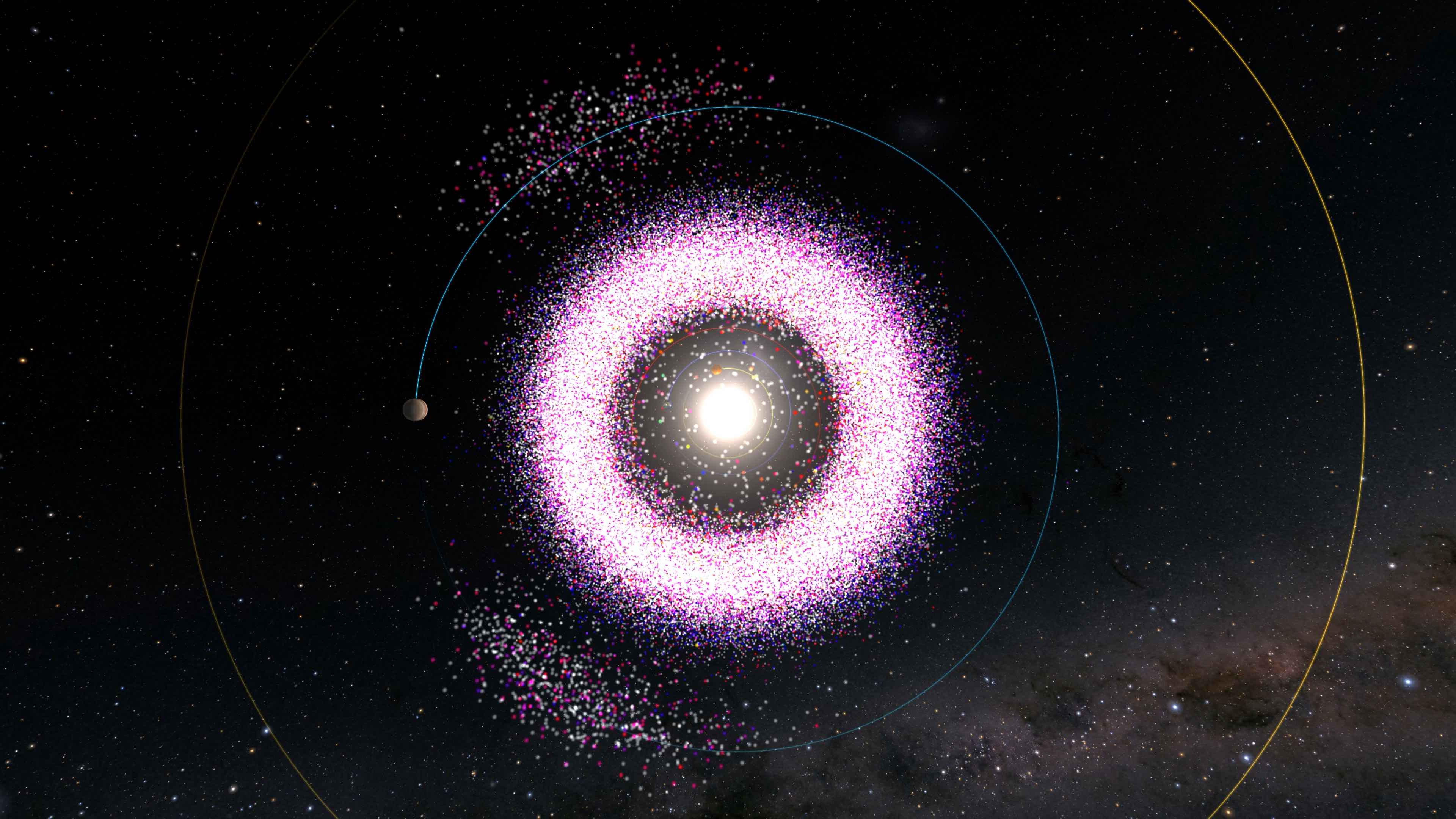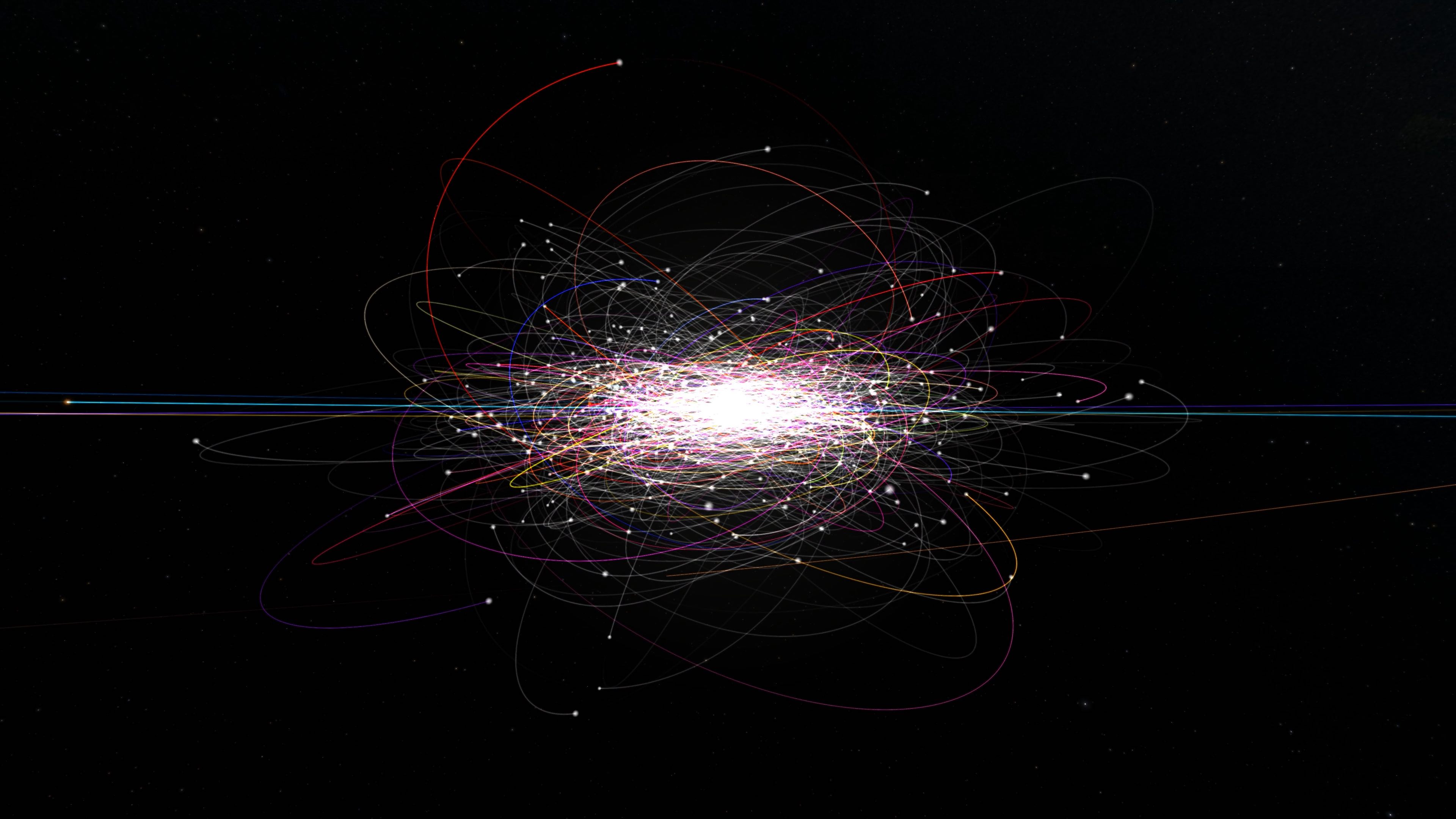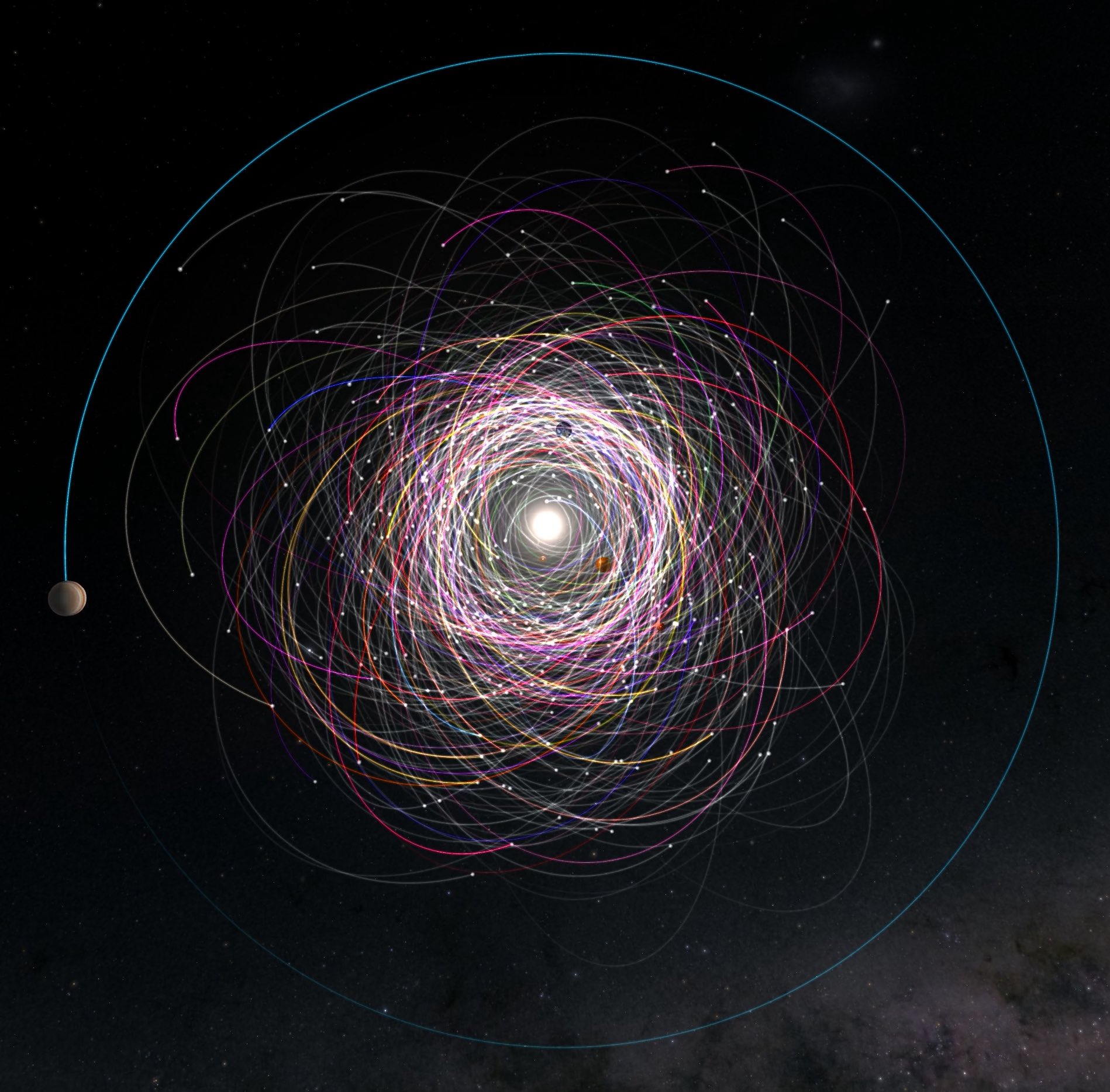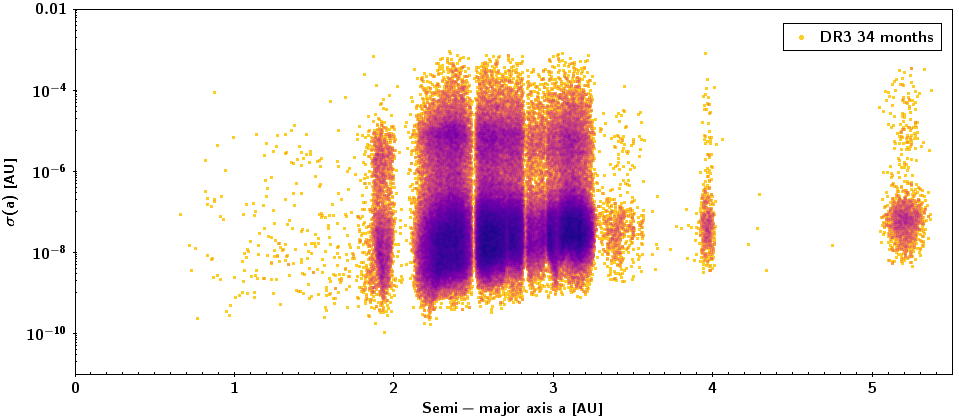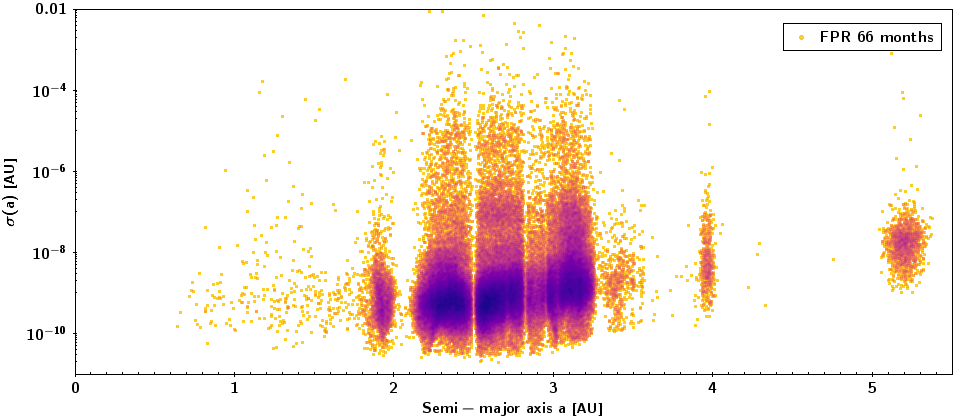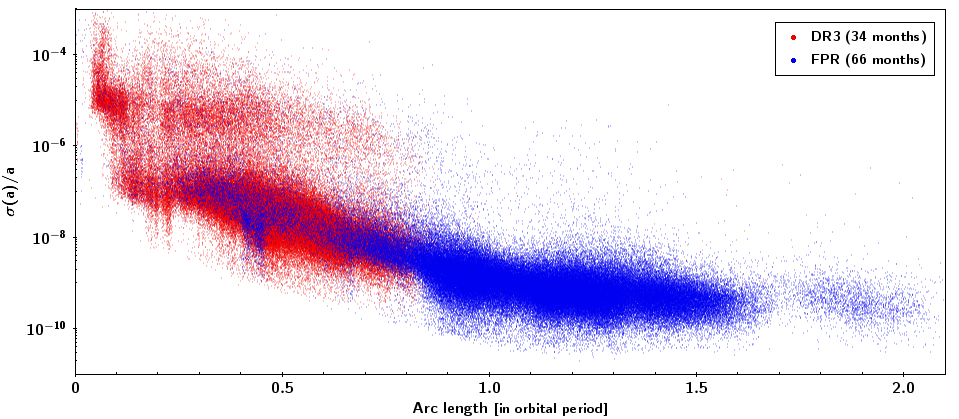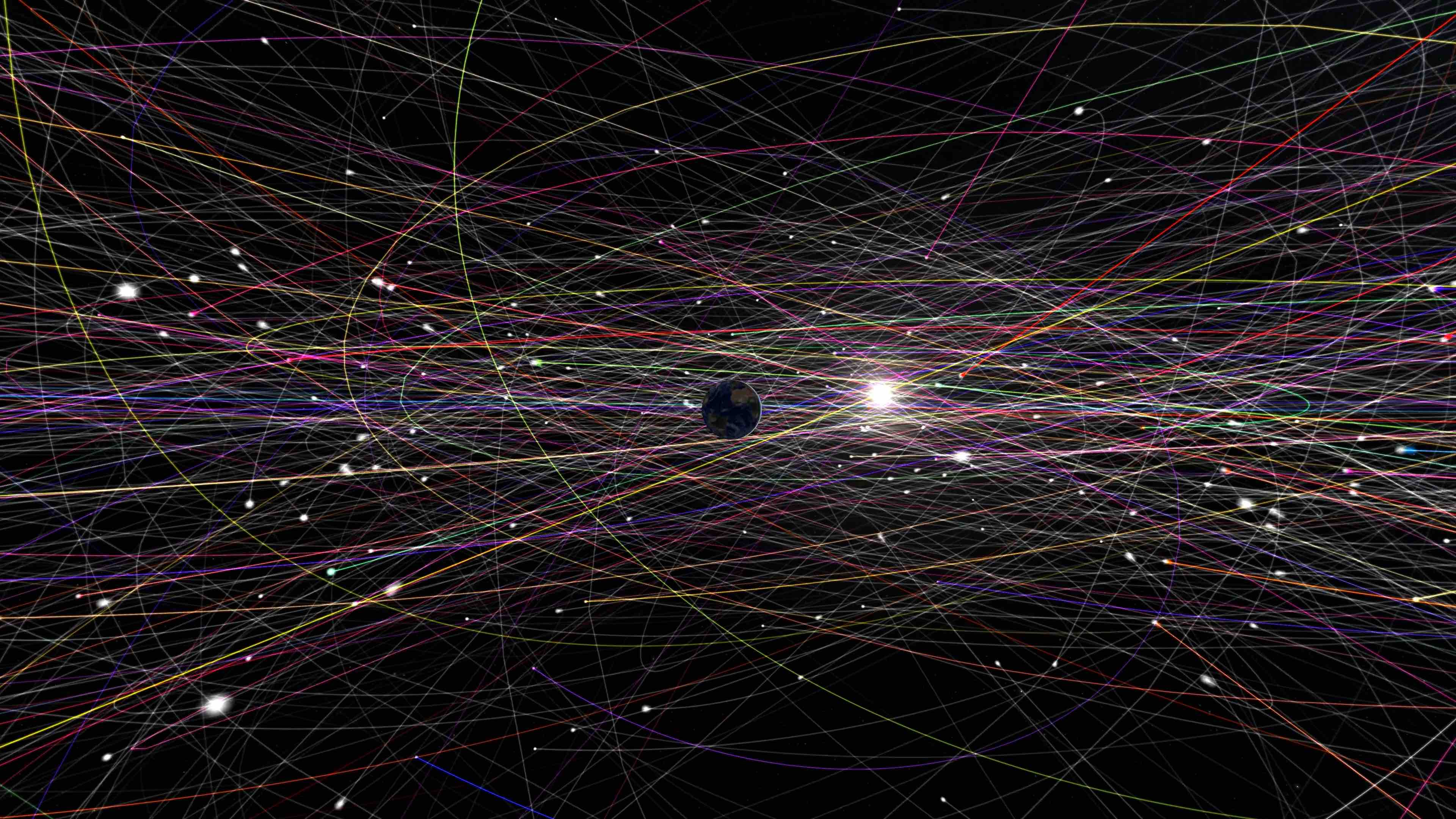Updated orbits for solar system objects - Gaia
Gaia Focused Product Release
Unlocking the secrets of solar system objects - Gaia's surprising role
The Gaia space mission is primarily designed to map with extreme precision the positions, parallaxes, and proper motions of over a billion stars in the Milky Way and beyond, creating an exceptionally detailed three-dimensional stellar catalogue. However, this mission also contributes to the detection and characterization of solar system objects (SSOs), such as asteroids and moons of planets. In fact, although the mission design was not optimized for SSO detection, thanks to systematic measurements taken with Gaia has performed measurements of positions a hundred times more precise compared to previous ones obtained over past decades. But how can Gaia contribute to SSO science?
Figure 1. Overview of asteroids in Gaia's Focused Product Release. The inner (less visible) blue orbit represents the orbit of the Earth, the outer blue orbit shows Jupiter's orbit. The trojans, asteroids clustered together a bit ahead and behind of Jupiter are clearly visible. The Main Belt is the region heavily populated with asteroids between Mars and Jupiter. Gaia's Trans-Neptunian Objects are not shown in this plot. Credits: ESA/Gaia/DPAC - CC BY-SA 3.0 IGO. Acknowledgements: Screenshot of video created by Stefan Jordan, Toni Sagristà, Paolo Tanga with Gaia Sky.
Gaia's roles in solar system object detection
Thanks to data analysis it is possible to compare the calculated positions of the chosen asteroids with the sources observed by Gaia. Since asteroids move, it’s necessary to consider the exact time of each observation: if the position predicted for the asteroid and the one measured by Gaia matches, it is possible to confirm that the source is the asteroid searched for. Furthermore, it is also possible to check some moving sources that do not correspond to positions of known objects. These enter a small list of 'unmatched asteroids' (about 1% of the total number of objects in the release). If indeed their characteristics do not match those of any of the previously known asteroids, they could represent the discovery of a new one with Gaia.
The remaining 99% of sources are known asteroids. With the updated positions and orbits in Gaia’s Focused Product Release, the future positions of asteroids can be predicted much better, serving various important purposes.
Figure 2. Visualisation of the Gaia's asteroids. Credits: ESA/Gaia/DPAC - CC BY-SA 3.0 IGO. Acknowledgements: Screenshot of video created by Stefan Jordan, Toni Sagristà, Paolo Tanga with Gaia Sky.
An example of the precision measurements that can be performed concerns Yarkovsky's small acceleration, a recoil force due to the emission of thermal infrared radiation. This effect can be used for understanding how the asteroid belt evolved and how dangerous asteroids are brought into Earth-crossing orbits. This force has the characteristic of changing the orbit size of small asteroids (<10 km) at a very slow rate. To measure this, highly accurate astrometry is needed, as is provided by Gaia.
In conclusion, by looking carefully into anomalies of the asteroid trajectories, it is also possible to measure subtle effects due to their shape or detect asteroid satellites. Only positions observed by Gaia are so precise as to permit this measurement on many solar system objects.
Gaia's past observation of solar system objects
In 2018, with Gaia’s Data Release 2, the first data set related to solar system objects was released. This consisted of a relatively small sample (~14,000) though of high quality. Two types of data were published: epoch astrometry and epoch photometry in the visible band, covering a 22-month observation period.
In 2022, with the advent of Gaia’s Data Release 3, more than 10 times the number of asteroids and several planetary moons were made available compared to the previous Data Release 2 (~157,000), spanning different asteroid classes. This release, covering a 34-month observation period, also included epoch astrometry and wide-band visible epoch photometry and in addition featured two new data products: orbits and spectral data of the bodies.
Figure 3. Visual portfolio of some data properties for asteroids in Gaia Data Release 3. In the image the distribution on the semi-major axis of objects belonging to the main populations are shown (eight Centaurs are excluded though). This image was published in 2022, in view of Gaia DR3, but is still applicable to the Gaia FPR data set as well. Credits: Tanga, et al. 2022 - CC BY-SA 3.0 IGO.
Present: What's new in this Gaia Focused Product Release?
Thanks to the new Focused Product Release on 10 October 2023, Gaia has taken another leap forward in the study of solar system objects. In this release, data for ~156,000 of these objects with a longer observation time span of 66 months has become available. This extended observation time has allowed for a significant achievement: for almost all asteroids, one full orbit has been measured, rather than just segments of it. This allowed to achieve 20 times more precise orbits compared to Gaia Data Release 3. Combined with the Gaia stellar catalogue, this accomplishment has a significant positive impact on mass determinations and predictions of stellar occultations, where an asteroid passes in front of a star and temporarily dims the starlight in a way that follows its figure. Occultation timing observations from a variety of locations across the occultation path on the globe enable an accurate measurement of asteroid shapes, their rings and satellites.
Figure 4. Left: Gaia DR3 orbits, with formal uncertainty of the semi-major axis of orbits versus the semi-major axis of the orbit for the Gaia DR3 SSO data (based on 34 months of observations). Right: the FPR orbits, based on 66 months of observations, are a factor 20 more precise. The clumps in both panels denote various asteroid families. The colour scale denotes the number of objects. Credits: Gaia Focused Product Release: Asteroid orbital solution by Gaia Collaboration, P. David, et al. 2023
Figure 5. In red: The formal uncertainty of the semi-major axis of orbits versus the observed arc length of the orbit for the Gaia DR3 SSO data (based on 34 months of observations). In blue: Gaia FPR arc length clearly improved compared to Gaia DR3. For almost all objects, one full orbit has been measured now. Credits: Gaia Focused Product Release: Asteroid orbital solution by Gaia Collaboration, P. David, et al. 2023
What can we expect in the future?
The improvements do not stop here: even more significant developments can be anticipated with Gaia’s Data Release 4 which is not expected before the end of 2025. In this case, twice as many asteroids (~350,000) compared to the current Gaia FPR will be published, among which there may be previously undiscovered ones. The time span will remain the same, but there will be a much greater variety of new data types. In addition to epoch astrometry, wide-band visible epoch photometry, spectral data, and orbits, all of which were part of previous data releases, spin and shape parameters, and precise masses of the largest asteroids will be made available.
Figure 6. Infographic highlighting the contents of the Gaia data releases with respect to solar system objects, starting with Gaia’s Data Release 2 in 2018 where Gaia released for the first time data for about 14,000 asteroids. Gaia’s Data Release 3 brought, next to positions and brightness, also orbits and spectra for about 158,000 asteroids. With Gaia’s Focused Product Release, updated astrometry is published for the same set of asteroids. The orbit precision for the solar system objects in Gaia FPR is on average 20 times better compared to Gaia DR3. With the next data release, Gaia DR4, even more data products are expected, such as spin, mass and shape parameters, for twice the number of objects. Legend with explanation on the symbols used can be found here. Credits: ESA/Gaia/DPAC - CC BY-SA 3.0 IGO. Acknowledgements: created by Mariasole Agazzi, Paolo Tanga, Tineke Roegiers, Daniel Hestroffer, Jos de Bruijne.
As for the stars, Gaia is providing astrometric and photometric measurements with unprecedented precision and accuracy, for already more than five years. After Gaia’s Data Release 3, in fact, the specific star data obtained by Gaia helps to improve even asteroids never observed by Gaia itself. Using older observations from ground in combination with Gaia’s star data, updated positions can be computed for many asteroids. In fact, these updates following the release of Gaia’s star data aids in protecting Earth from potential asteroid impacts, and assist in mission planning for SSO exploration by space probes.
In summary, while the Gaia mission is primarily dedicated to studying stars in the Milky Way, its observations are extremely valuable for the detection, monitoring, characterization, and pinpointing of solar system objects, contributing to the understanding of the formation, structure, and evolution of our solar system.
With this data release, orbits for nearly 157,000 asteroids were significantly improved. These new orbits, based on up to 5.5 years of Gaia data, outperform decades of ground-based observations in terms of precision. To illustrate this, an asteroid named 'Wolfratshausen' with a five-kilometer diameter is focused on. By comparing pre-Gaia ground-based observations with Gaia's data, it can be seen clearly how Gaia's precision revolutionizes our understanding of asteroid orbits. The green cloud of asteroid positions in Gaia's data is remarkably compact, highlighting the progress made in just 5 years compared to 31 years of pre-Gaia observations. Credits: ESA/Gaia/DPAC - CC BY-SA 3.0 IGO. Acknowledgements: Based on the paper "Focus Product Release: Asteroid orbital solution" by Gaia Collaboration, P. David, et al. 2023 / Data: Pedro David / Video: Stefan Jordan, Toni Sagristà, / Text: Stefan Jordan, Tineke Roegiers, Paolo Tango. / Visualisation: with „Gaia Sky“, developed by Toni Sagristà.
Further reading
- Paper: Gaia Focused Product Release: Asteroid orbital solution by Gaia Collaboration, P. David , et al. 2023
- Gaia Data Release 3: "It is an asteroid? - The objects in our Solar System seen by Gaia"
Figure 7. Visualisation of the Gaia's asteroids. Credits: ESA/Gaia/DPAC - CC BY-SA 3.0 IGO. Acknowledgements: Screenshot of video created by Stefan Jordan, Toni Sagristà, Paolo Tanga with Gaia Sky.
Story written by Mariasole Agazzi, Tineke Roegiers, Daniel Hestroffer, Paolo Tanga, Pedro David, François Mignard, Jos de Bruijne
Credit: ESA/Gaia/DPAC
Contact email: Gaia Helpdesk
Published: 10-10-2023
- Removed a total of (21) style text-align:center;
- Removed a total of (11) style text-align:justify;
More Gaia Focused Product Release stories?
COSMOLOGY:
Gaia's gravitational lens search around quasars
Solar System:
Updated astrometry for Gaia's Solar System Objects
Variability:
Gaia's extended radial velocity epoch data for Long Period Variables
Interstellar Medium:
Diffuse Interstellar Bands from Gaia's Radial Velocity Spectra
Globular Clusters:
Gaia's additional data from engineering images taken in crowded regions
-
ESA's press release for Gaia's Focused Product Release
-
- Removed a total of (15) style text-align:center;








































 Sign in
Sign in
 Science & Technology
Science & Technology
